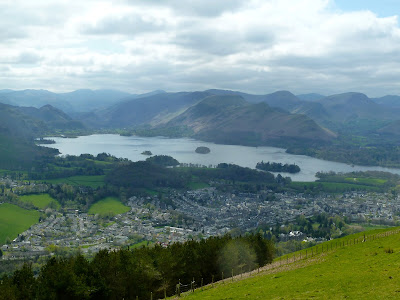 |
| Caledonian Forest below Beinn Dubhcraig |
 |
| Purple Saxifrage? below Beinn Dubhcraig |
 |
| Ben Oss and Ben Lui from Beinn Dubhcraig |
 |
| Ben Lui from Ben Oss |
 |
| Beinn Dubhcraig from Ben Oss |
Good Friday was always the day for the annual family walk when I was a youngster. A thermos flask of tea, an aluminium sandwich tin with meat or fish paste sandwiches, a boiled egg, an apple and, if we were lucky, a penguin biscuit for a picnic lunch. We caught the Ribble bus from Preston to Longridge and walked up Jeffrey Hill by the little-used road that runs along its summit ridge and passes the reservoirs that provided Preston with its water supply or Longridge Pop as it was known. It established a ritual and I have always regarded Good Friday as sacrosanct for walking. I have managed many good walks in recent years and it was a chance to get some solace after a hectic few weeks working in Shetland. Today was predicted to be a dry warm sunny day so I planned to climb the 4 Munros by Tyndrum. They are dominated by Ben Lui, the highest of the four.
Ascent: 1625 metres
Distance: 22 kilometres
Time: 6 hours 50 minutes
Beinn Dubhcraig 977m 1hr 58mins
Ben Oss 1029m 3hrs 12mins
Ben Lui 1130m 4hrs 49mins
Beinn a' Chleibh 916m 5hrs 25mins
The morning mist promised a day of warm sunny weather although the hills were lost in low clouds during the drive up to Dalrigh just before Tyndrum. The traffic was heavy at the start of the Easter weekend. Surprisingly, on one of the busiest days of the year, there were several sections of resurfacing taking place after the winter damage to the roads. I had decided to climb the four hills east to west and the south-easterly breeze endorsed this decision. I have done the four hills together on four occasions twice in each direction and the route planned today was a replica of the route taken in 1995 when I led a party of six on the Water Aid Munro Challenge to Ben Oss. I persuaded two colleagues to climb the four hills whilst the others retired to a pub after Ben Oss where we met them afterwards.
The climb up Ben Dubhcraig is always tricky, After crossing the railway line there is a good track but it is important to cross the burn and ascend through the Caledonian forest and then the plantations on the higher slopes. Having negotiated the plantation, I decided to climb the northeast ridge, which although a little longer, provided a good route to the summit. It was coolish at this height but a T-shirt sufficed and I was walking well. The sun had burnt off the cloud but it was still hazy so photographs were less clear than I had hoped.
I had a short break on the cairn and on the descent met and had a long chat with a Glaswegian who was attempting the same route but had only recently taken-up hill walking 'as a means of keeping healthy' - good decision. The route across to Ben Oss is deceptive and for the second time I made the mistake of following the path which keeps low to the east of the hill and I ended up having to double back to make the summit. The views of Ben Lui were good and Loch Oss provided a sense of remoteness nestling between the two Munros.
There is a 350-metre drop to the bealach from Ben Oss before the ascent of Ben Lui can be attempted. I was surprised to find the energy to make a steady pace to the summit which was a climb of 450 metres. It was quite windy and after a short stop for a drink, I continued, jogging down to the next bealach and making good pace up to the undistinguished Beinn a' Chleibh. I had decided to drop down to the A85 rather than go back over Ben Lui and past the goldmine but this meant banking on hitching a lift which is usually a bit optimistic. On the descent, I met my Glasgow friend who said that he had been chasing me all day but had given up on the ascent of Ben Lui.
I returned to Fionne Coire and descended down the corrie on the waterlogged path to the forestry plantations below, followed the burn down to the railway track and waded the river Lochy. I managed to hitch a lift back to Tyndrum with a Mancunian Irishman who was in a party of 4 cars full of people who had come to Scotland for 11 days to escape the royal wedding hysteria. He dropped me by Paddy's bar in Tyndrum and I walked the last few kilometres back to the car incensed by the lack of provision for cyclists or walkers on this section of the A82. I was home before 6pm and, on checking my previous outings, discovered that this was my fastest round of the four hills; there was still life in the legs.




































